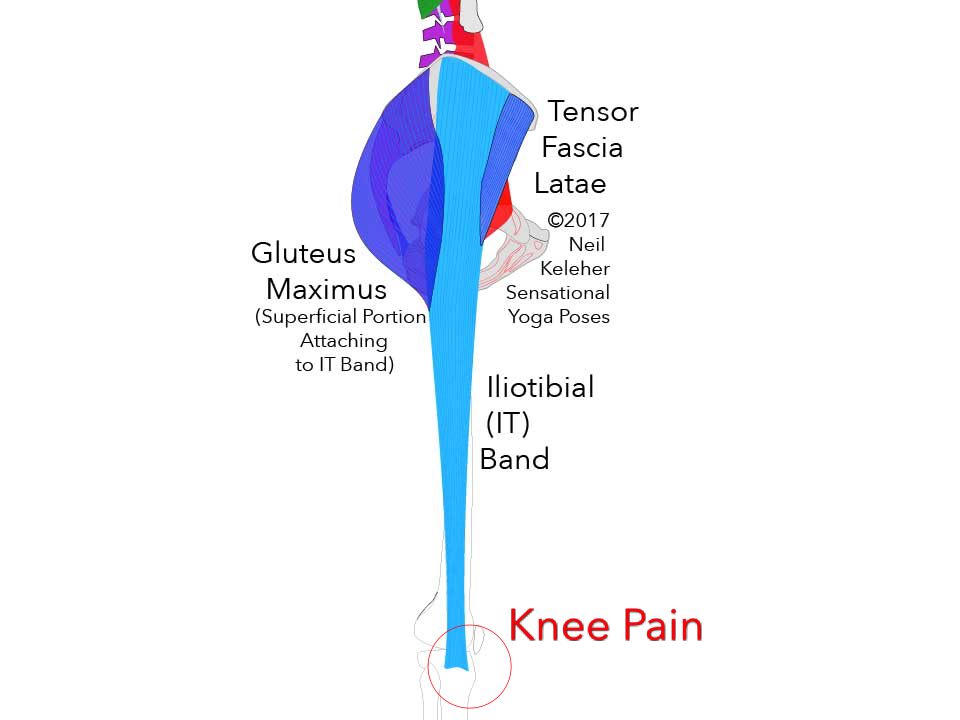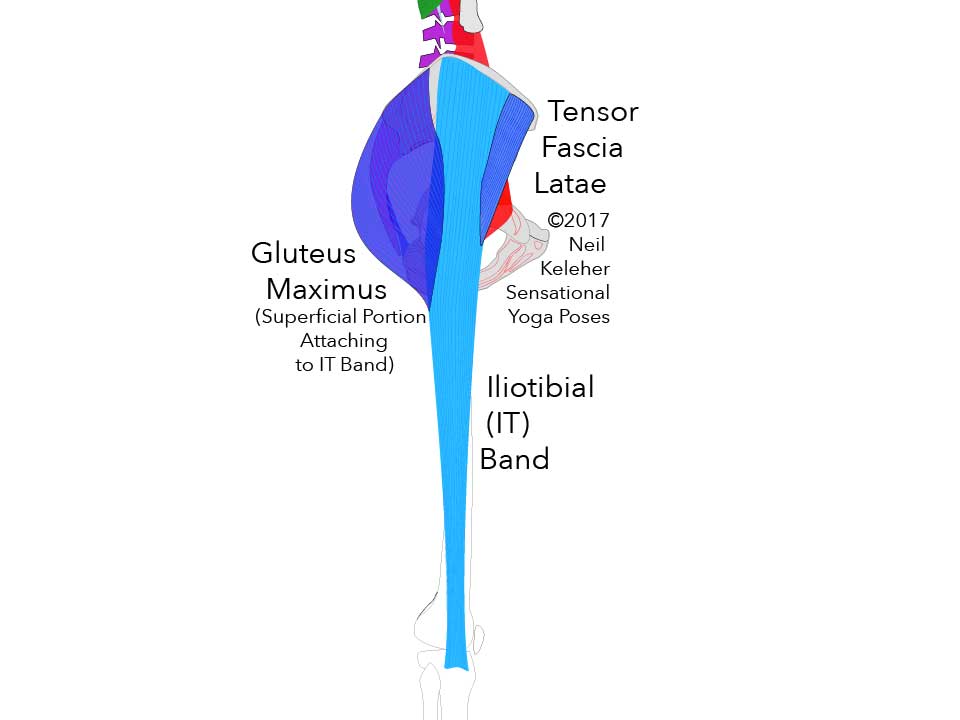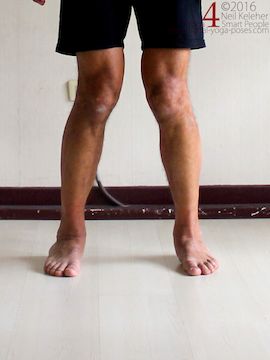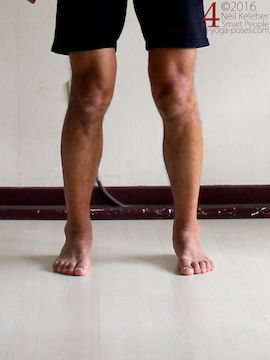The IT Band
The IT Band is a band of connective tissue that runs down the side of the thigh from the crest of the hip to the tibia. You could think of it as a really long flat tendon, or better yet, two long tendons (one at the front, one at the rear) that are joined along most of their length.
Muscles that Act on the IT Band
The muscles that pull directly on the IT band are the superficial portion of the Gluteus Maximus and the Tensor Fascia Latae.
Since the IT band runs over the Vastus Lateralis muscle, activation of that muscle can also push out against it effectively taking out the slack.
- The Tensor Fascia Latae is a small muscle that attaches from the ASIC, the front point of the hip crest.
- The Superficial fibers of the Gluteus Maximus (the butt muscle) attach to the back edge of the IT band from the rearmost portion of the hip crest.
- The Vastus Lateralis muscle lies beneath the IT band. It is the outermost of the three large vastus muscles that make up the bulk of muscle at the front of the thigh.
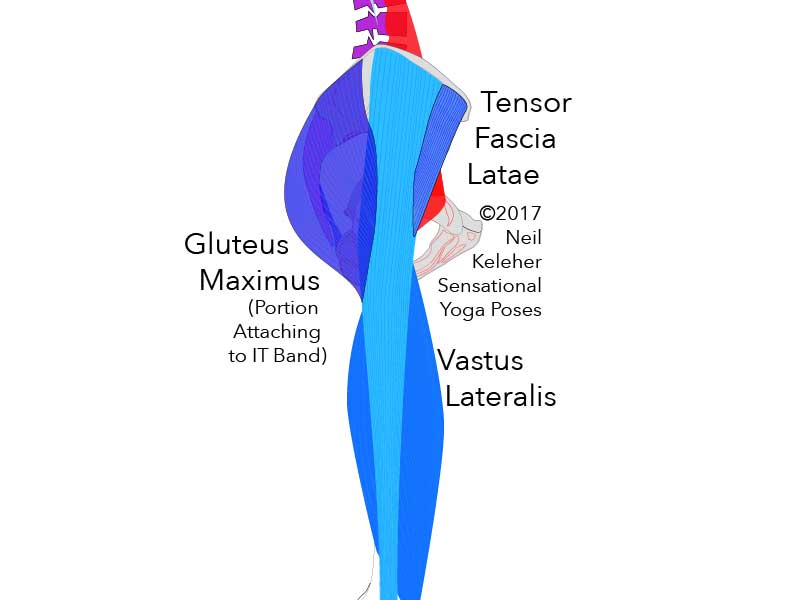
The IT Band passes over the Vastus Lateralis muscle.
Muscles that Can Anchor the IT Band
Two muscles that share the same connective tissue envelope with the IT band at the lower end are the Tibialis Anterior which runs down the front of the shin and the Peroneus Longus which runs down the side of the shin.
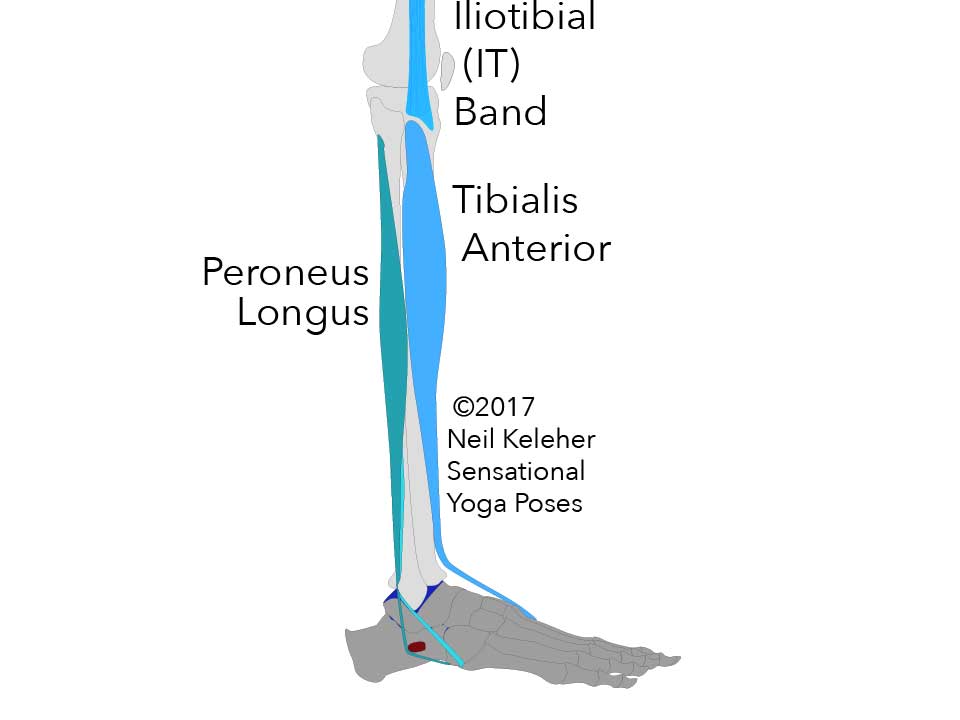
The Tibialis Anterior, Peroneus Longus and IT band.
This image does not show the fibers that are continuous between those muscles and the IT Band.
At the upper end is the External Obliques, particularly the fibers of that muscle that run from the lower ribs to the ASIC.
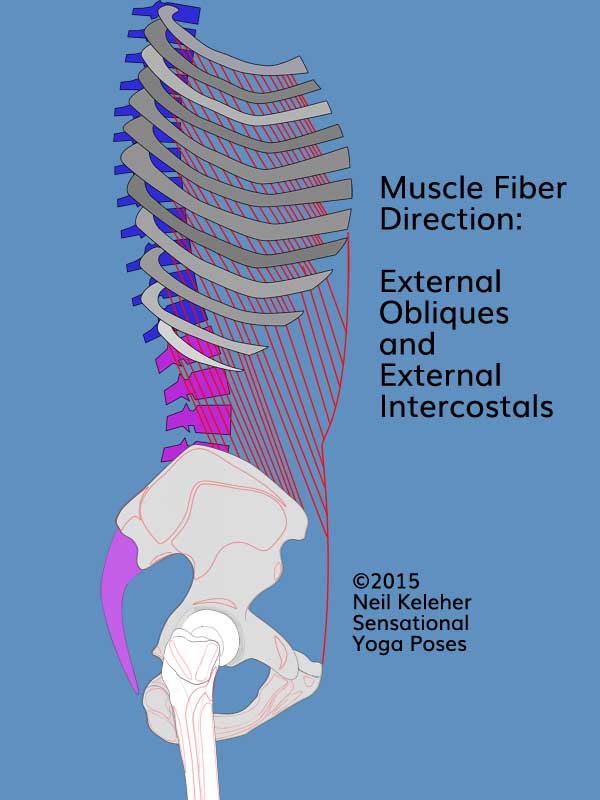
The external obliques (and external intercostals).
With respect to the IT Band, the fibers of interest are those running from the lower ribs (ribs 11 and 12) to the ASIC, the front point of the hip crest.
For a general overview of the internal and external obliques (including tips for learning to feel and control them) you can read Obliques and Intercostals.
The IT Band and Shin Rotation
One way in which the Tensor Fascia Latea and Gluteus Maximus can work via the IT band is to rotate the shins. Standing with weight on both legs:
- The tensor fascia latae can be used to rotate the shins internally. This will cause the knees to move inwards.
- The gluteus maximus can be used to rotate them externally. This will cause the knees to move outwards.
It is possible for the shins to rotate relative to the thighs when the knees are bent (but not when they are straight). While standing I find that when using the IT band muscles to rotate the shins, the knees will move inwards with internal rotation and outwards with external rotation.
While the shins can rotate relative to the thighs with the knees bent, the IT band muscles tend to rotate the shin and thigh together whether the knee is bent or straight which would make sense if, as some sources suggest, the IT band has direct connective tissue connections to the vastus lateralis muscle along the outside of the thigh.
Shin Rotation Relative to the Foot
Shins rotated inwards.
Shins neutral.
With the feet on the floor the shins can rotate relative to the feet.
- In this case internal rotation of the shins causes the inner arch of the feet to flatten.
- External rotation of the shins raises the inner arch of the feet higher.
This can occur whether the knees are bent or straight.
The muscles that rotate the shins relative to the feet can include tibialis posterior, peroneus longus, peroneus brevis and tibialis anterior.
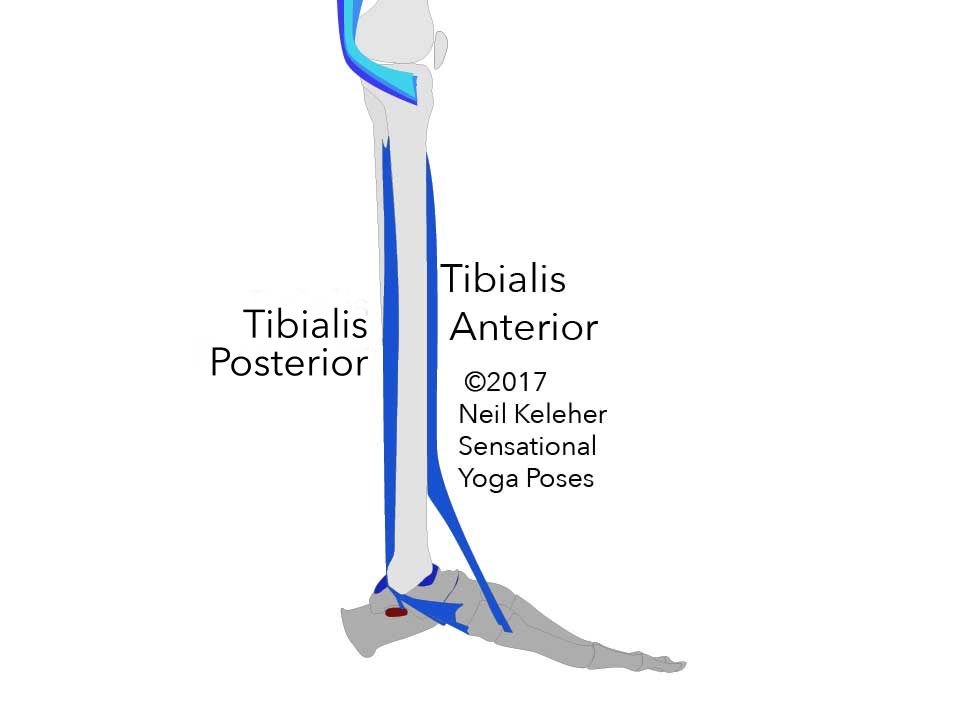
Tibialis Posterior attaches to the rear surfaces of the tibia and fibula.
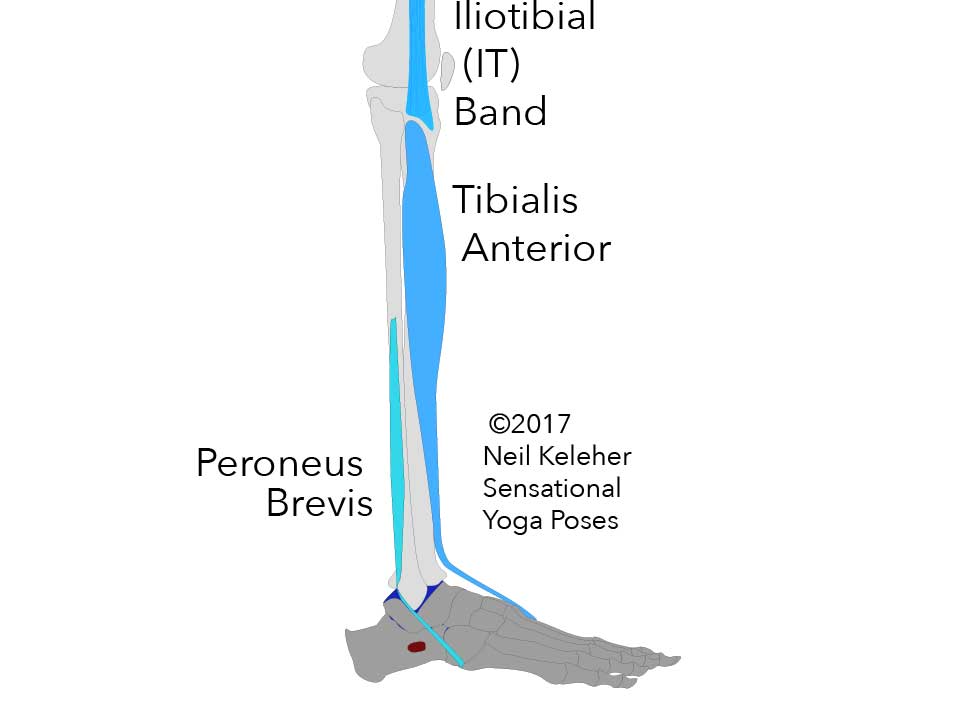
Peroneus Brevis attaches to the outer surface of the fibula.
Recall that both the tibialis anterior and peroneus longus (shown previously) both have connective tissue connections to the IT Band.
With the feet on the floor, body weight provides a way of stabilizing the feet.
The long muscles of the lower leg then have a stable foundation from which they can rotate the shin relative to the foot.
Working against each other these muscles can also activate to stabilize the shin relative to the foot.
If the feet are on the floor and the shin bones are stable then the IT band muscles have a stable foundation from which to work on the hip bones. However, for the IT band muscles to work on the shin bones it helps if the hip bones are stable.
One way give the IT band muscles a stable foundation at the hip bone is to stabilize the hip joint. Another way is to stabilize the same side SI Joint and lumbar spine.
Using the IT Band Muscles to Rotate the Pelvis or the Shin
Standing with weight on one foot you could stabilize the foot, ankle and shin of the standing leg.
With the shin stable the IT band muscles of the standing leg can be used to turn the pelvis left or right.
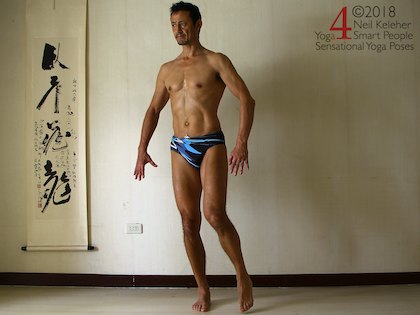
Using the Tensor Fascia Latae to help rotate the pelvis towards the standing leg. (Shin stabilized against rotation)
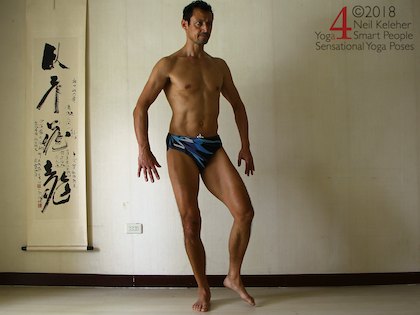
Using the Gluteus Maximus to help rotate the pelvis away from the standing leg. (Shin stabilized against rotation).
They can also be used to help lift or lower the opposite hip.
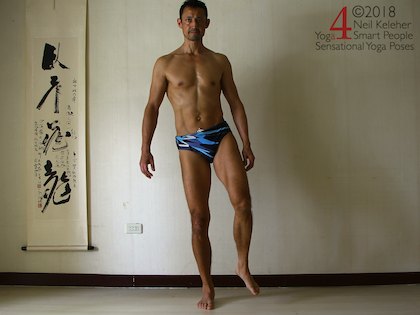
Tensor fascia latae and gluteus maximus could help raise the opposite hip while standing by actively shortening.
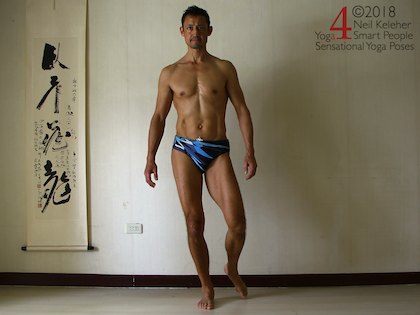
Tensor fascia latae and gluteus maximus could help lower the opposite hip under control standing by actively lengthening.
If you stabilized the hip of the standing leg you could use the IT Band muscles of the lifted leg to rotate the lifted leg internally or externally.
Joint Lubrication
An important idea to understand when trying to fix knee pain is that the knee joint (like the other synovial joints) are designed to maintain space between the femur and tibia.
In this case the knee joint is similiar to a car tire.
In a car tire air pressure keeps the rim of the wheel from banging into the pavement.
With synovial joints like the knee joint, tension in the joint capsule pressurizes synovial fluid and prevents the femur from contacting the tibia and vice versa.
Tension in the joint capsule envelope helps to prevent synovial fluid from being squeezed out from between the bones and this is how the joint is kept lubricated.
The actual space required within a synovial joint is quite small.
Different Lubrication Methods
When a fluid film is maintained between mating surfaces via fluid pressure, the lubrication method is called hydrostatic lubrication.
Note that it is possible for fluid pressure to be created by relative movement of the bone ends. In this case the lubrication method is termed hydrodynamic lubrication.
With hydrodynamic lubrication, fluid pressure is a result of relatively fast movement while with hydrostatic lubrication fluid pressure occurs as a direct result of muscle activation.
If either of the two previous methods fail then when the mating surfaces do meet then the fall back lubrication method is via boundary layer lubrication.
When all three methods fail, the lack of lubrication can result in tissue damage due to undesired frictional forces. This in turn causes joint failure.
Hydrostatic Lubrication Relies of Muscle Control
For hydrostatic lubrication to work, muscles that cross or affect the knee joint have to work together to maintain appropriate joint capsule tension.
In any position of the knee (and depending on whether the leg was bearing body weight or only the weight of the lower leg) different muscles have to work together to maintain knee joint lubrication.
If you squeeze a water balloon in the middle, the balloon would bulge at either end since fluid is incompressible.
If you somehow applied pressure at the two bulging ends, then your hands have some resistance.
You could increase hand pressure to squeeze the ends apart, or reduce hand pressure so that the ends can move towards each other.
Lubrication Pressure Warning Signals
If any muscle that works across the knee joint doesn't work as required in a particular position (say like the bottom position of a squat), then hydrostatic lubrication can fail.
And so the brain may be programmed to turn on pain when a muscle isn't working properly in a particular postion.
If this is the case then knee pain could be the equivalent of an oil warning light. The problem in this case isn't a lack of lubricant, but a potential lack of lubrication pressure due to a muscle not working properly in the painful position.
In this case, knee pain would be the brains way of preventing you from repeating actions that, over the long term, could result in long term damage to knee joint.
Joints Are Critical Structures
While muscles have some overlap, some redundancy, joints do not. And so it would make sense that the brain is programmed to prioritize joint protection.
Muscle Control Basics
While joints are priority structures, muscle control is what helps to maintain joint integrity. The question then is "What do muscles need in order to function as required?"
To Create Change, You Need Stability
One of the most basic aspects of muscle control is similiar to erecting a building.
One of the first things constructed when building a building is the foundation. And from there, each floor or story helps to provide the foundation for the story above.
You could think of the act of building a building as "creating a change." To create change you need stability. Without stability, desired change is a little harder to create.
For muscles to be able to function effectively, one end of a muscle needs to be fixed. You could think of this fixed end as the foundation or anchor point.
If a muscle isn't functioning properly one of the first things to check is "does it have a stable foundation?" Does it have a stable end point?
Anchoring the IT Band to Prevent Knee Pain
The IT band has three main points of attachment, the tibia, and the front and back points of the hip crest.
One idea for preventing IT band knee pain is to anchor the IT band at any of these points.
One way to create stability or an anchor point for a muscle is to prevent one bony attachment point from moving. Another is to activate a muscle with which the IT band has a connective tissue connection.
At the lower end of the IT band two muscles in this latter category are the tibialis anterior and the peroneus longus.
Anchoring the Lower End of the IT Band
One "muscle activation trick" that can help to activate both of these muscles is to stabilize the heels against lateral tilt.
A rough guide to heel stabilization is included in shin rotations and heel stability.
If you are already fairly body aware and have good muscle control, experiment with activating tibialis anterior and/or tibialis posterior while standing and then while squatting without weight.
If it works, then try squatting with weight.
You may find that stabilizing the heels is enough to prevent knee pain since it tends to automatically cause the tibialis anterior and peroneus longus to activate.
If it doesn't, then you may need to explore muscle control with deeper a step-by-step approach as included in sensational leg anatomy.
If neither of these two actions helps, try anchoring the upper end of the IT band.
Anchoring the Upper End of the IT Band
To anchor the front element of the IT Band, try creating an upward pull on the ASIC. Since this can be created by using the external obliques you may find it helpful to first lift your chest, moving it away from your pelvis.
Then try creating an upwards pull on the ASIC on the problem side.
Since the fibers of the external obliques that attach to the ASIC also attach to the lower back ribs, you may find it even more helpful to lift your lower back ribs (in the region of your kidneys) and then create an upwards pull on the ASIC.
Note that another way of creating an upwards pull on the ASIC is to create a downwards pull on the ischial tuberosity or sitting bone. (This too is covered in sensational leg anatomy)
Once you've created an upward pull on the ASIC you may find it helpful to then activate the Tensor Fascia Latae.
Try creating an outwards on the ASIC's to activate the Tensor Fascia Latae.
Anchoring the Upper Rear Portion of the IT Band
For the rear element of the IT band, you could try tilting the pelvis forwards so that that PSICs (the Posterior portion of the Iliac crest or "Posterior Superior Iliac Crest") lift up relative to the back of the knee.
You may find this more effective with respect to IT band induced knee pain if you focus on feeling the back points of your hip crest, particularly on the same side as the afflicted knee.
You may find that you gluteus maximus activates automatically as you do this, particularly if you are upright. But if not, try activating them to see if that prevents IT band pain.
Adjusting Shin Rotation
Depending on whether you habitually have excessively lifted inner arches, or relatively flat inner arches, you may find it helpful to adjust shin rotation relative to your feet.
If, for example, you have relatively flat feet you may find it helpful to rotate your shins outwards relative to your feet.
If you have the opposite problem, then you could try rotating your shins inward.
How much you rotate in either direction you'll have to determine by feel. The amount you need to rotate in either direction may be slight!
Note that you may have to vary shin rotation along with creating a stable foundation for the IT band.
Muscle Control Basics 2
Another aspect of muscle control is adding or subtracting tension from a muscle so that it can operate effectively.
This is similiar to pre-stretching an elastic band so that it can actually do work.
If the distance between end points is too short the elastic will not have any tension.
If it is too long then the elastic might break if any additional tension is added.
At just the right length an elastic can function effectively and have a long lifespan.
Removing IT Band Slack with the Vastus Lateralis
With the IT band, you can adjust tension by activating (or relaxing) the vastus lateralis muscle.
Activating the vastus lateralis could be thought of as "taking out the slack" from the IT band.
With slack removed from the IT Band it can effectively transmit force from the tensor fascia latae or gluteus maximus to the lower leg bones. And this may be enough to prevent knee pain. If not, then you may still need to create stability.
Removing IT Band Slack with the Deep Portion of the Gluteus Maximus
With respect to the rear element of the IT Band another way of adjusting tension is via the deep fibers of the Gluteus maximus muscle which attach directly to the femur.
When these fibers activate they push out against the superficial fibers, taking out slack if there is any.
Suggestions for Implementation
Probably the simplest and most basic fix for knee pain is to experiment with stability.
- First try anchoring the bottom end of the IT band by activating the Tibialis Anterior and Tibialis Posterior.
- Also play with stabilizing the upper end of the IT band by creating an upward pull on the ASIC.
- Then try tilting the pelvis forwards so that you effectively create an upwards pull on the PSIC.
- If you still have problems, try taking out the slack by activating the vastus lateralis.
- Also try taking out the slack by activating gluteus maximus.
For all of these actions, you may find it helpful to also make the spine feel long.
When trying any of the above fixes while squatting, move slowly and smoothly.
Aim for 5 seconds to go down and 5 seconds to come up.
And rather that relaxing at the bottom of the squat, hold tension. Stay active.
And if you are doing a squat with weight, work with body weight first, and then gradually add more weight.
If you still experience IT band pain while squatting, you may need to look at the pes anserinus muscles since these also rotate the shin.
If you experience IT band pain while running, you may need to look at shin and heel stability.
For problems with the inside of the knee you may find Sartorius and Inner Knee Pain helpful.
For more on possible knee joint lubrication mechanisms, look at the bursae of the knee. You can also read Fluid Tensegrity Joint Anatomy.
For more on leg muscle control, with practical exercises for learning to feel and control major muscles of the leg from the hip bone down to the toes, Sensational Leg Anatomy is a series of videos that teaches a progression of muscle control exercises that you can do while standing.
Published: 2020 08 05
Updated: 2021 01 29
